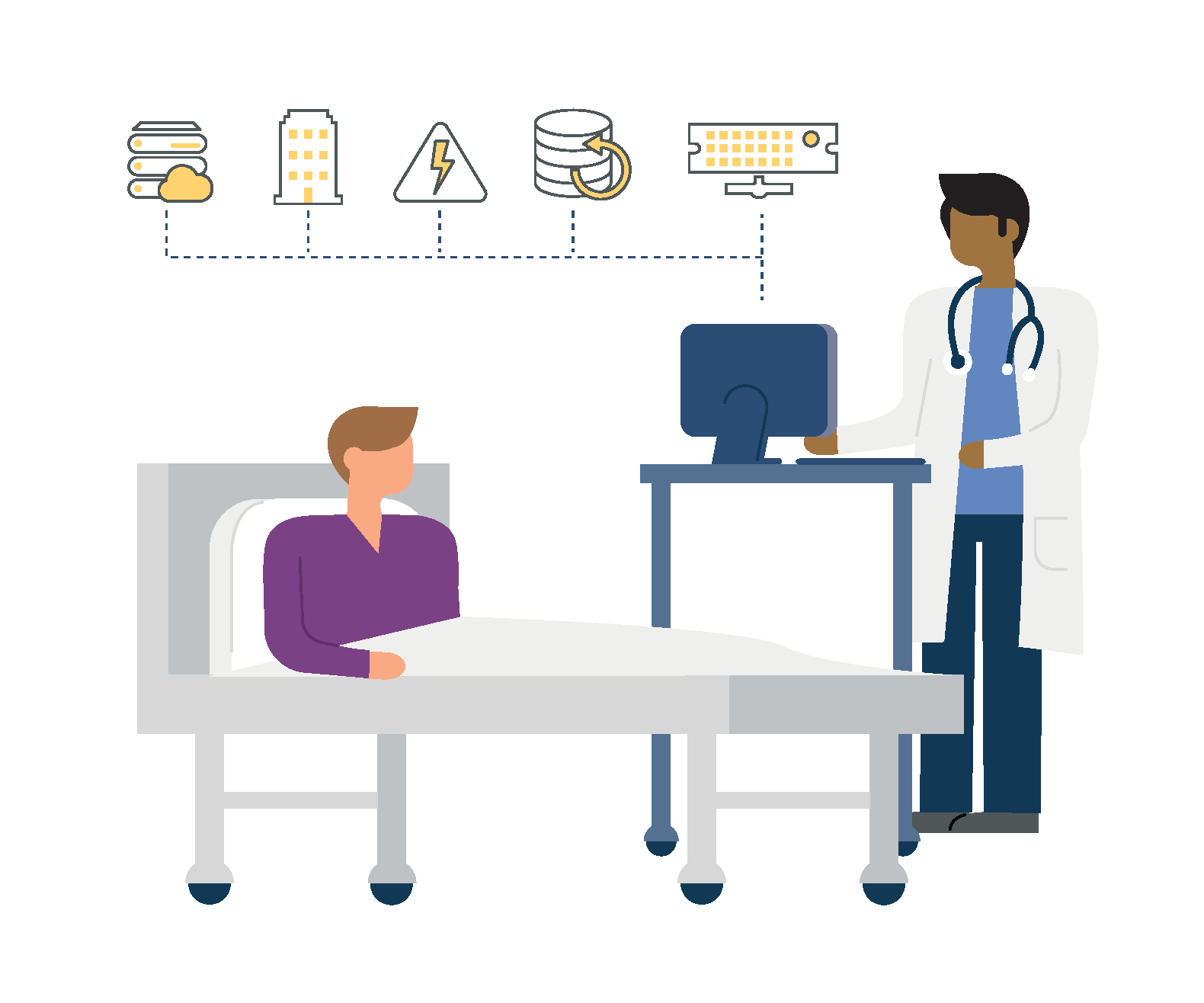HealthcareAI
The AI arms race in healthcare: Innovation without compromise
There are several key factors that healthcare organizations should consider when it comes to keeping up with the race…
Read article

Healthcare Assessment & Optimization
12/01/2020
by Arsalan Nadeem and Ryan Cantrell

Is your healthcare IT organization ready for growth? Are you keeping your organization’s operational costs in check? Are you conducting business efficiently?
Believe it or not, healthcare organizations who answer “Yes” to these questions have one thing in common: they prioritize their Information Technology (IT) Infrastructure and are aware of its importance.
Investing in the infrastructure of a healthcare IT department is often looked at as a “necessary evil” – something that gets kicked to the bottom of the strategic IT roadmap as more exciting initiatives take precedence. But what if instead of a “necessary evil,” we looked at infrastructure investments as a means of fostering an upgraded physician and customer experience, elevating patient care, and driving innovative solutions?
Whether your organization is adding new clinical applications, creating a state-of-the-art facility, or hiring the best physicians and nurses; a weak healthcare IT infrastructure foundation will inhibit your organization from achieving long-term success and will prevent you from truly optimizing high-priority needs like telehealth.
Updating technology stacks creates the breathing room an organization needs to be flexible and pivot in the ever-changing digital landscape in healthcare. With a focus on modernizing infrastructure, healthcare organizations can decrease operational costs, enable higher quality healthcare, increase reliability, and improve IT staff satisfaction.
Decreases long-term operational costs
Upgrading infrastructure is often met with pushback since system upgrades require higher upfront costs. However, the average spend for older, less efficient IT infrastructure tends to be higher over time. Much of this has to do with parts going out of stock (loss of time), expensive legacy maintenance contracts, and/or increased use of data center capabilities (such as square footage and cooling). These costs can easily be decreased for healthcare organizations that already have such high operational costs to begin with by investing in newer infrastructure.
With newer, much more efficient IT hardware, organizations can think long-term and achieve major cost savings when upgrading critical pieces of their technology at the right times. While there are contractual obligations over warranties and support models that strategic sourcing can optimize, teams may find greater strength in paying close attention to how old their hardware is.
Enables higher quality healthcare
By having newer hardware, healthcare organizations can focus on using complex, robust systems to support patients; such as supporting new and improved Electronic Health Records (EHR) deployments, which incorporate numerous applications across different interfaces. While these systems market themselves to be the latest and greatest for physicians, infrastructure enables them to run at an accelerated rate. Whether it’s a simple report, uploading files, sending documents, or waiting on an application to provide a result/calculation; modernized infrastructure provides the grease for faster processing and fewer disruptions to a physician’s workflow.
Increases reliability
New and improved hardware helps create a more reliable and redundant infrastructure to reduce planned and unplanned outages or downtimes. Hardcoded solutions are becoming a thing of the past as stretched networks and new monitoring tools enable systems to automatically connect active endpoints upon failure. Newer hardware also enables better disaster recovery and business continuity solutions, allowing applications to be recovered quickly with little to no impact.
Increases IT workforce satisfaction
Aging IT infrastructure can bleed into a heavy break-fix environment with more emphasis on service ticket management. This eventually leads to a model with fewer engineer resources on strategic initiatives and keeps the focus on more remedial break-fix tasks. By reinforcing IT infrastructure importance, employees can wield new tools and systems that allow room for professional development. Not only does this inspire confidence with ever-changing technologies, but helps the talent pipeline as the organization grows.

To achieve the benefits above, healthcare organizations should invest in the following IT infrastructure work streams: Compute, Storage/Backup, Network/Telecom, Disaster Recovery, and Data Center. These workstreams are the building blocks of IT infrastructure for healthcare organizations.
Compute
The days of counting your team’s servers on two hands and naming them after Greek gods are long gone (maybe not the naming part, but still!). Healthcare organizations have seen an exponential increase in virtual machines (VM’s) being spun up; similar to Moore’s Law with the doubling of transistors every two years. When looking to upgrade compute infrastructure, healthcare organizations need to decide a few things: should an organization purchase hyper-converged systems (all-in-one system) or traditional converged systems, application feasibility/compatibility, operating systems (Windows, Linux, AIX), hardware life, and patching schedules.
Storage/Backup
Yes, it is actually possible for organizations to run out of storage space, which is why Storage and Backup are key work streams as healthcare organizations continue to grow. Additional storage capacity is needed to increase efficiencies and ensure that organizations have the space to store important patient data. When looking at storage arrays, healthcare organizations should focus on high capacity arrays, speed, and life of the hardware. Healthcare organizations need to decide which type of storage works best for their applications such as, all-flash vs. disk-based. Organizations also need to invest in enterprise backup solutions to ensure clinical and non-clinical data can be made available quickly during episodes of data corruption or loss. Finally, healthcare IT organizations should ensure they implement sync and replication policies between storage and backup hardware to ensure data redundancy and availability across data centers.
Network/Telecom
From varying types of incoming 5G networks to providers and customers calling into contact centers over medical billing, coding, and appointment scheduling – Network/Telecom needs are ever-increasing across enterprises. When looking at upgrading network and telecom infrastructure, teams should focus on minimizing latency speeds, expanding wireless availability, forecasting device usage, creating a standardized telephony system, and installing Application Centric Infrastructure (ACI) leaf-spine redundancy. Physicians and patients need reliable, quick devices, and applications if they are going to support the future of remote patient monitoring and establish telehealth capabilities.
Disaster Recovery (DR)
Disaster Recovery has made its way to be a bolt-on for a lot of system deployments, utilizing VLAN/VIP networks reaching different data centers or regions that cloud companies designate. Although this is considered a value-add for any pitch, DR should be a requirement when implementing new hardware to minimize any loss of patient data and application downtimes. Healthcare organizations need a strategic effort across multiple disciplines to regularly test the failover and failback of these systems so that when a failure/major disaster occurs, the system can be back up running in minutes instead of hours or days.
Data Center
Along with upgrading the actual systems that support the healthcare organization, you must also invest in the facility that will house your systems and infrastructure. Healthcare organizations need to expand data centers for square footage, add efficient cooling units, and install backup power generators. Investing in these items can increase the life of your systems and ensure overall reliability and uptime.
Now, pulling together all of these capabilities and workstreams into a desired future state may seem overwhelming. However, the best first step is figuring out where your healthcare organization falls on the overall readiness spectrum for each of these infrastructure workstreams and tackling the highest priority areas first. Examine each workstream closely and work with application teams to put a plan together to decide which aspects are worth investing in further, and hit the ground running!
Infrastructure is the base foundation of all of your organization’s technologies – and the ultimate goal is to possess a strong foundation that enables your organization to innovate and compete in a healthcare market that is ever-changing.
Business insights
HealthcareAI
There are several key factors that healthcare organizations should consider when it comes to keeping up with the race…
Read article

Healthcare
While private equity investment in healthcare is valuable, providers should familiarize themselves with alternative…
Read article

HealthcareOptimize Technology
Advancements in health tech have allowed both patients and clinicians to experience the benefits of digital…
Read article
